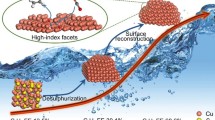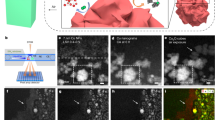Abstract
The development of heterogeneous catalysts with a well-defined micro structure to promote their activity and stability for electrocatalytic CO2 reduction has been shown to be a promising strategy. In this work, Cu nanoparticles (∼ 4 nm in diameter) embedded in N-doped carbon (Cu@NC) arrays were fabricated by thermal decomposition of copper tetracyanoquinodimethane (CuTCNQ) under N2. Compared to polycrystalline copper electrodes, the Cu@NC arrays provide a significantly improved number of catalytically active sites. This resulted in a 0.7 V positive shift in onset potential, producing a catalytic current density an order magnitude larger at a potential of–2.7 V vs. Fc/Fc+ (Fc = ferrocene) in dimethylformamide (DMF). By controlling the water content in the DMF solvent, the CO2 reduction product distribution can be tuned. Under optimal conditions (0.5 vol% water), 64% HCOO–, 20% CO, and 13% H2 were obtained. The Cu@NC arrays exhibited excellent catalytic stability with only a 0.5% decrease in the steady-state catalytic current during 6 h of electrolysis. The three-dimensional (3D) array structure of the Cu@NC was demonstrated to be effective for improving the catalytic activity of copper based catalysts while maintaining long-term catalytic stability.

Similar content being viewed by others
References
Seh, Z. W.; Kibsgaard, J.; Dickens, C. F.; Chorkendorff, I.; Nørskov, J. K.; Jaramillo, T. F. Combining theory and experiment in electrocatalysis: Insights into materials design. Science 2017, 355, eaad4998.
Qiao, J. L.; Liu, Y. Y.; Hong, F.; Zhang, J. J. A review of catalysts for the electroreduction of carbon dioxide to produce low-carbon fuels. Chem. Soc. Rev. 2014, 43, 631–675.
Kondratenko, E. V.; Mul, G.; Baltrusaitis, J.; Larrazábal, G. O.; Pérez-Ramírez, J. Status and perspectives of CO2 conversion into fuels and chemicals by catalytic, photocatalytic and electrocatalytic processes. Energy Environ. Sci. 2013, 6, 3112–3135.
Banerjee, A.; Dick, G. R.; Yoshino, T.; Kanan, M. W. Carbon dioxide utilization via carbonate-promoted C–H carboxylation. Nature 2016, 531, 215–219.
Li, Y. W.; Sun, Q. Recent advances in breaking scaling relations for effective electrochemical conversion of CO2. Adv. Energy Mater. 2016, 6, 1600463.
Chen, T. Y.; Rodionov, V. O. Controllable catalysis with nanoparticles: Bimetallic alloy systems and surface adsorbates. ACS Catal. 2016, 6, 4025–4033.
Appel, A. M.; Bercaw, J. E.; Bocarsly, A. B.; Dobbek, H.; DuBois, D. L.; Dupuis, M.; Ferry, J. G.; Fujita, E.; Hille, R.; Kenis, P. J. A. et al. Frontiers, opportunities, and challenges in biochemical and chemical catalysis of CO2 fixation. Chem. Rev. 2013, 113, 6621–6658.
Liu, M.; Pang, Y. J.; Zhang, B.; De Luna, P.; Voznyy, O.; Xu, J. X.; Zheng, X. L.; Dinh, C. T.; Fan, F. J.; Cao, C. H. et al. Enhanced electrocatalytic CO2 reduction via field-induced reagent concentration. Nature 2016, 537, 382–386.
Singh, M. R.; Kwon, Y.; Lum, Y.; Ager, J. W.; Bell, A. T. Hydrolysis of electrolyte cations enhances the electrochemical reduction of CO2 over Ag and Cu. J. Am. Chem. Soc. 2016, 138, 13006–13012.
Li, F. W.; Chen, L.; Knowles, G. P.; MacFarlane, D. R.; Zhang, J. Hierarchical mesoporous SnO2 nanosheets on carbon cloth: A robust and flexible electrocatalyst for CO2 reduction with high efficiency and selectivity. Angew. Chem., Int. Ed. 2017, 56, 505–509.
Klinkova, A.; De Luna, P.; Dinh, C. T.; Voznyy, O.; Larin, E. M.; Kumacheva, E.; Sargent, E. H. Rational design of efficient palladium catalysts for electroreduction of carbon dioxide to formate. ACS Catal. 2016, 6, 8115–8120.
Chen, Y. H.; Kanan, M. W. Tin oxide dependence of the CO2 Reduction efficiency on tin electrodes and enhanced activity for tin/tin oxide thin-film catalysts. J. Am. Chem. Soc. 2012, 134, 1986–1989.
Rasul, S.; Anjum, D. H.; Jedidi, A.; Minenkov, Y.; Cavallo, L.; Takanabe, K. A highly selective copper-indium bimetallic electrocatalyst for the electrochemical reduction of aqueous CO2 to CO. Angew. Chem., Int. Ed. 2015, 54, 2146–2150.
Zhu, W. L.; Michalsky, R.; Metin, Ö.; Lv, H. F.; Guo, S. J.; Wright, C. J.; Sun, X. L.; Peterson, A. A.; Sun, S. H. Monodisperse Au nanoparticles for selective electrocatalytic reduction of CO2 to CO. J. Am. Chem. Soc. 2013, 135, 16833–16836.
Huan, T. N.; Simon, P.; Benayad, A.; Guetaz, L.; Artero, V.; Fontecave, M. Cu/Cu2O electrodes and CO2 reduction to formic acid: Effects of organic additives on surface morphology and activity. Chem.—Eur. J. 2016, 22, 14029–14035.
Hori, Y. Electrochemical CO2 reduction on metal electrode. In Modern Aspects of Electrochemistry; Vayenas, C. G.; White, R. E.; Gamboa-Aldeco, M. E., Eds.; Springer: New York, 2008.
Chen, L.; Guo, S. X.; Li, F. W.; Bentley, C.; Horne, M.; Bond, A. M.; Zhang, J. Electrochemical reduction of CO2 at metal electrodes in a distillable ionic liquid. ChemSusChem 2016, 9, 1271–1278.
Lu, Q.; Rosen, J.; Zhou, Y.; Hutchings, G. S.; Kimmel, Y. C.; Chen, J. G.; Jiao, F. A selective and efficient electrocatalyst for carbon dioxide reduction. Nat. Common. 2014, 5, 3242.
Studt, F.; Behrens, M.; Kunkes, E. L.; Thomas, N.; Zander, S.; Tarasov, A.; Schumann, J.; Frei, E.; Varley, J. B.; Abild-Pedersen, F. et al. The mechanism of CO and CO2 hydrogenation to methanol over Cu-based catalysts. ChemCatChem 2015, 7, 1105–1111.
Varela, A. S.; Ju, W.; Reier, T.; Strasser, P. Tuning the catalytic activity and selectivity of Cu for CO2 electroreduction in the presence of halides. ACS Catal. 2016, 6, 2136–2144.
Cheng, T.; Xiao, H.; Goddard, W. A. Reaction mechanisms for the electrochemical reduction of CO2 to CO and formate on the Cu(100) surface at 298 K from quantum mechanics free energy calculations with explicit water. J. Am. Chem. Soc. 2016, 138, 13802–13805.
Kuhl, K. P.; Cave, E. R.; Abram, D. N.; Jaramillo, T. F. New insights into the electrochemical reduction of carbon dioxide on metallic copper surfaces. Energy Environ. Sci. 2012, 5, 7050–7059.
Peterson, A. A.; Abild-Pedersen, F.; Studt, F.; Rossmeisl, J.; Nørskov, J. K. How copper catalyzes the electroreduction of carbon dioxide into hydrocarbon fuels. Energy Environ. Sci. 2010, 3, 1311–1315.
Ren, D.; Ang, B. S.-H.; Yeo, B. S. Tuning the selectivity of carbon dioxide electroreduction toward ethanol on oxidederived CuxZn catalysts. ACS Catal. 2016, 6, 8239–8247.
Larrazábal, G. O.; Martín, A. J.; Mitchell, S.; Hauert, R.; Pérez-Ramírez, J. Enhanced reduction of CO2 to CO over Cu–In electrocatalysts: Catalyst evolution is the key. ACS Catal. 2016, 6, 6265–6274.
Dutta, A.; Rahaman, M.; Luedi, N. C.; Mohos, M.; Broekmann, P. Morphology matters: Tuning the product distribution of CO2 electroreduction on oxide-derived (OD) Cu foam catalysts. ACS Catal. 2016, 6, 3804–3814.
Lee, S.; Kim, D.; Lee, J. Electrocatalytic production of C3-C4 compounds by conversion of CO2 on a chloride-induced Bi-phasic Cu2O-Cu catalyst. Angew. Chem., Int. Ed. 2015, 54, 14701–14705.
Li, C. W.; Kanan, M. W. CO2 reduction at low overpotential on Cu electrodes resulting from the reduction of thick Cu2O films. J. Am. Chem. Soc. 2012, 134, 7231–7234.
Gupta, K.; Bersani, M.; Darr, J. A. Highly efficient electroreduction of CO2 to formic acid by nano-copper. J. Mater. Chem. A 2016, 4, 13786–13794.
Matsubara, Y.; Grills, D. C.; Kuwahara, Y. Thermodynamic aspects of electrocatalytic CO2 reduction in acetonitrile and with an ionic liquid as solvent or electrolyte. ACS Catal. 2015, 5, 6440–6452.
Oh, Y.; Vrubel, H.; Guidoux, S.; Hu, X. L. Electrochemical reduction of CO2 in organic solvents catalyzed by MoO2. Chem. Comm. 2014, 50, 3878–3881.
Qiao, X. X.; Li, Q. Q.; Schaugaard, R. N.; Noffke, B. W.; Liu, Y. J.; Li, D. P.; Liu, L.; Raghavachari, K.; Li, L. S. Well-defined nanographene–rhenium complex as an efficient electrocatalyst and photocatalyst for selective CO2 reduction. J. Am. Chem. Soc. 2017, 139, 3934–3937.
MacFarlane, D. R.; Forsyth, M.; Howlett, P. C.; Kar, M.; Passerini, S.; Pringle, J. M.; Ohno, H.; Watanabe, M.; Yan, F.; Zheng, W. J. et al. Ionic liquids and their solid-state analogues as materials for energy generation and storage. Nat. Rev. Mater. 2016, 1, 15005.
Alvarez-Guerra, M.; Albo, J.; Alvarez-Guerra, E.; Irabien, A. Ionic liquids in the electrochemical valorisation of CO2. Energy Environ. Sci. 2015, 8, 2574–2599.
Huan, T. N.; Andreiadis, E. S.; Heidkamp, J.; Simon, P.; Derat, E.; Cobo, S.; Royal, G.; Bergmann, A.; Strasser, P.; Dau, H. et al. From molecular copper complexes to composite electrocatalytic materials for selective reduction of CO2 to formic acid. J. Mater. Chem. A 2015, 3, 3901–3907.
Liu, Y. L.; Li, H. X.; Tu, D. Y.; Ji, Z. Y.; Wang, C. S.; Tang, Q. X.; Liu, M.; Hu, W. P.; Liu, Y. Q.; Zhu, D. B. Controlling the growth of single crystalline nanoribbons of copper tetracyanoquinodimethane for the fabrication of devices and device arrays. J. Am. Chem. Soc. 2006, 128, 12917–12922.
Heintz, R. A.; Zhao, H. H.; Ouyang, X.; Grandinetti, G.; Cowen, J.; Dunbar, K. R. New insight into the nature of Cu(TCNQ): Solution routes to two distinct polymorphs and their relationship to crystalline films that display bistable switching behavior. Inorg. Chem. 1999, 38, 144–156.
McDonald-Wharry, J.; Manley-Harris, M.; Pickering, K. Carbonisation of biomass-derived chars and the thermal reduction of a graphene oxide sample studied using Raman spectroscopy. Carbon 2013, 59, 383–405.
Wan, L.; Shamsaei, E.; Easton, C. D.; Yu, D. B.; Liang, Y.; Chen, X. F.; Abbasi, Z.; Akbari, A.; Zhang, X. W.; Wang, H. T. ZIF-8 derived nitrogen-doped porous carbon/carbon nanotube composite for high-performance supercapacitor. Carbon 2017, 121, 330–336.
Hellgren, N.; Haasch, R. T.; Schmidt, S.; Hultman, L.; Petrov, I. Interpretation of X-ray photoelectron spectra of carbon-nitride thin films: New insights from in situ XPS. Carbon 2016, 108, 242–252.
Gammon, W. J.; Kraft, O.; Reilly, A. C.; Holloway, B. C. Experimental comparison of N(1s) X-ray photoelectron spectroscopy binding energies of hard and elastic amorphous carbon nitride films with reference organic compounds. Carbon 2003, 41, 1917–1923.
Gennaro, A.; Isse, A. A.; Severin, M.-G.; Vianello, E.; Bhugun, I.; Savéant, J.-M. Mechanism of the electrochemical reduction of carbon dioxide at inert electrodes in media of low proton availability. J. Chem. Soc., Faraday Trans. 1996, 92, 3963–3968.
Amatore, C.; Saveant, J. M. Mechanism and kinetic characteristics of the electrochemical reduction of carbon dioxide in media of low proton availability. J. Am. Chem. Soc. 1981, 103, 5021–5023.
Zhao, S.-F.; Horne, M.; Bond, A. M.; Zhang, J. Is the imidazolium cation a unique promoter for electrocatalytic reduction of carbon dioxide? J. Phys. Chem. C 2016, 120, 23989–24001.
Li, Q.; Zhu, W. L.; Fu, J. J.; Zhang, H. Y.; Wu, G.; Sun, S. H. Controlled assembly of Cu nanoparticles on pyridinic-N rich graphene for electrochemical reduction of CO2 to ethylene. Nano Energy 2016, 24, 1–9.
Nossol, E.; Nossol, A. B. S.; Guo, S.-X.; Zhang, J.; Fang, X.-Y.; Zarbin, A. J. G.; Bond, A. M. Synthesis, characterization and morphology of reduced graphene oxide-metal-TCNQ nanocomposites. J. Mater. Chem. C 2014, 2, 870–878.
Vasylets, G. Y.; Starodub, V. A.; Barszcz, B.; Graja, A.; Medviediev, V. V.; Shishkin, O. V.; Bukrinev, A. S. Structure and spectral properties of TCNQ salts with Zn(II) and Ni(II) 2,2′-bipyridine complexes. Synth. Met. 2014, 191, 89–98.
Acknowledgements
The authors gratefully acknowledge technical assistance from Mr. Philip Holt for the GC measurements and Dr. Peter Nichols for the NMR measurements. X. L. Z. acknowledges Monash University for provision of postgraduate scholarship support. The authors acknowledge the use of facilities in the Monash Centre for Electron Microscopy.
Author information
Authors and Affiliations
Corresponding author
Electronic supplementary material
12274_2017_1936_MOESM1_ESM.pdf
Ultra-small Cu nanoparticles embedded in N-doped carbon arrays for electrocatalytic CO2 reduction reaction in dimethylformamide
Rights and permissions
About this article
Cite this article
Zhang, X., Zhang, Y., Li, F. et al. Ultra-small Cu nanoparticles embedded in N-doped carbon arrays for electrocatalytic CO2 reduction reaction in dimethylformamide. Nano Res. 11, 3678–3690 (2018). https://doi.org/10.1007/s12274-017-1936-1
Received:
Revised:
Accepted:
Published:
Issue Date:
DOI: https://doi.org/10.1007/s12274-017-1936-1




